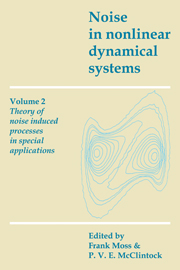Book contents
- Frontmatter
- Contents
- List of contributors
- Preface
- Introduction to Volume 2
- 1 Stochastic processes in quantum mechanical settings
- 2 Self-diffusion in non-Markovian condensed-matter systems
- 3 Escape from the underdamped potential well
- 4 Effect of noise on discrete dynamical systems with multiple attractors
- 5 Discrete dynamics perturbed by weak noise
- 6 Bifurcation behavior under modulated control parameters
- 7 Period doubling bifurcations: what good are they?
- 8 Noise-induced transitions
- 9 Mechanisms for noise-induced transitions in chemical systems
- 10 State selection dynamics in symmetry-breaking transitions
- 11 Noise in a ring-laser gyroscope
- 12 Control of noise by noise and applications to optical systems
- 13 Transition probabilities and spectral density of fluctuations of noise driven bistable systems
- Index
4 - Effect of noise on discrete dynamical systems with multiple attractors
Published online by Cambridge University Press: 05 January 2012
- Frontmatter
- Contents
- List of contributors
- Preface
- Introduction to Volume 2
- 1 Stochastic processes in quantum mechanical settings
- 2 Self-diffusion in non-Markovian condensed-matter systems
- 3 Escape from the underdamped potential well
- 4 Effect of noise on discrete dynamical systems with multiple attractors
- 5 Discrete dynamics perturbed by weak noise
- 6 Bifurcation behavior under modulated control parameters
- 7 Period doubling bifurcations: what good are they?
- 8 Noise-induced transitions
- 9 Mechanisms for noise-induced transitions in chemical systems
- 10 State selection dynamics in symmetry-breaking transitions
- 11 Noise in a ring-laser gyroscope
- 12 Control of noise by noise and applications to optical systems
- 13 Transition probabilities and spectral density of fluctuations of noise driven bistable systems
- Index
Summary
Introduction
The isolation of a physical system from its environment is a frequent approximation which leads to the idea of a deterministic conservative system. All physical systems are, however, coupled to the outside world, giving rise to the related phenomena of fluctuations and dissipation. In a dissipative dynamical system volumes in phase space contract onto attractors. Fluctuations allow the system to escape from attractors, rendering all attractors metastable. The long time behavior of a noisy dissipative system is thus intermittent, consisting of motion near the various attractors of the system alternating with transitions between attractors. In the limit of small noise, the times spent on the attractors become longer, and the transitions rarer. In this chapter we describe some recent work on stochastic dynamical systems with multiple attractors, with particular emphasis on systems possessing multiple limit cycles.
Although there has been much interest in noisy iterated maps, to our knowledge no one has actually derived a noisy map from a stochastic differential equation. In Section 4.2 we discuss some of the considerations that must go into any such derivation. As an example, we examine how noise affects a driven oscillator in both the phase-locked and unlocked regimes. The details of the noisy dynamics play an important role in determining how noise must affect the resulting map. Section 4.3 contains a formal derivation of a noisy iterated map from a linearized stochastic differential equation.
- Type
- Chapter
- Information
- Noise in Nonlinear Dynamical Systems , pp. 65 - 86Publisher: Cambridge University PressPrint publication year: 1989
- 5
- Cited by



